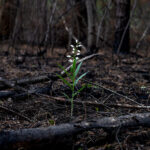The aeolian winds took control of the surrounding environment. A death-defying vortex formed and, along with it, a perturbation as inconceivable as the Camp Fire was overwhelming. This article continues to chronicle the story of a mega-disaster. Part 1 described how the Pacific Gas & Electric Company (PG&E) spent the last decade causing major life and property losses due to seemingly incompetent organizational leadership. In the next segment of the story, PG&E may not be the villain its public image would suggest. Other influences and factors that may have played a role in its public image will be revealed.
A red-flag warning is issued by the National Weather Service when winds are high and humidity is low. On 6 November 2018 – two days before the Camp Fire occurred – a red-flag warning was issued for most of the state of California. Over the next 48 hours, PG&E tweeted 17 different warnings of an impending electricity shut-off. The shut-off order was never given, leaving citizens and investigators to question, “Why?”.
Influencers
Research has shown several institutional, cultural, and mitigating influencers were at work in the unfolding of the Camp Fire catastrophe. The lack of a certain action or the making of a certain decision can only be explained in some examples as the direct result of a lifetime’s experience in the “that’s just the way it is” philosophy. Here are some examples of the influencers:
- Wildfires in California have a history of being wind-driven and creating tremendous losses.
- The roads were narrow, limited, and gridlocked quickly, resulting in abandoned vehicles and citizens fleeing on foot. The subject of road capacity was/is a political question being debated in the area.
- Paradise had a seldom exercised and limited evacuation plan. The evacuation plan called for sequential evacuation of each neighborhood instead of all at once due to limited street capacity.
- The 2005 state fire management plan identified an “east-wind” fire as the greatest risk to Paradise. The Jarbo Gap winds occur every year.
- Like many emergency agencies, Paradise planned for the most probable events in the community and not an event that is expected only once in 50 years.
- Climate change over the past decade as well as drought problems were constant in the state.
- PG&E considered a shut-off of power an action of last resort, and its policy indicated that no single factor drives the decision-making process. However, most experts opined that “high-wind speeds” should be given the most consideration.
Investigative Facts
The Camp Fire would come to be one of the most devastating fires to ever occur in California. It could also be considered one of the most investigated events in the history of the state. The disaster was investigated by a dozen news media agencies, numerous California state agencies (including regulatory and CalFire investigators), and various legal representatives for pending legal actions and insurance settlements.
The investigative facts revealed the following key points:
- At 4:00 a.m. on November 8, expected wind gusts were 55 mph and humidity less than 15%.
- In total, 86 people died and approximately 14,000 buildings were destroyed.
- The fire grew at a rate of 4,600 acres an hour. Analysis found the speed of the fire to be unprecedented.
- Evacuation initially worked as planned. However, CodeRed Logs (the town’s warning service provider) showed initial alert failure rates of 40%, loss of fiber optic lines and cell towers shut down the warnings.
- The PG&E pending shut-off never occurred. The action was canceled several hours after the start of the fire.
- The miracle of this disaster is how many citizens survived.
Final Decision
On 15 May 2019, California Department of Forestry and Fire Protection (CAL Fire) released their investigative report for the Camp Fire. The fire started in the early morning hours in the community of Pulga in Butte County. CAL FIRE determined that the Camp Fire was caused by electrical transmission lines owned and operated by PG&E located in the Pulga area. Dry vegetation and red-flag conditions promoted the fire and caused a quick burn to Concow, Paradise, Magalia, and the outskirts of East Chico.
The investigation also identified a second ignition sight near the intersection of Concow Road and Rim Road. The cause of the second fire was determined to be vegetation blowing into the PG&E electrical distribution lines. The second fire was ultimately consumed by the original fire.
The exact failure that resulted in the fire was traced to a C-Hook that had broken on a 115,000-volt line. PG&E internal documents show the average age of its transmission lines on the Caribou-Palermo line is 68 years old. PG&E normally inspected transmission lines every five years. However, PG&E delayed safety work on the Caribou-Palermo line and documented the need to replace most of the steel towers due to age and/or integrity.

Pacific Gas and Electric Co. has released a photograph of the broken hook on its Butte County power tower involved in the ignition of the deadliest and most destructive wildfire in California history in 2018 (Source: U.S. District Court).
Previously, on 26 November 2018, the California Public Utilities Commission (CPUC) Safety and Enforcement Division (SED) had determined in its report that the PG&E committed 12 safety violations related to the Camp Fire. Based on the investigations and the admission from PG&E that their equipment was at fault, PG&E declared bankruptcy as a direct result of the tens of billions of dollars in liabilities incurred from the 2017 and 2018 wildfires. Under the doctrine of inverse condemnation, California utilities may be held responsible for wildfire damage caused by their equipment, regardless of whether or not they were negligent.
An Image Problem
It could be said that PG&E cannot get out of its own way. Its public image has been highly questionable for a decade. As the fines accrue for regulatory failures and the revolving-door CEO policy continues, PG&E seems to be reinforcing the very image it wants so badly to change. Over the horizon, the impending reorganization will involve replacing nine of the twelve board members and another complete change in both leadership and policy direction.
Some would argue that things are getting worse for PG&E. The company has over 16 million customers and, in 2019, pre-emptively cut power to over one million of them. The company is working to resolve a dispute with Governor Gavin Newsom, who has questioned the amount of debt in the PG&E re-structuring plan. The governor has threatened a state takeover of the company. Also, California lawmakers have argued that PG&E is too large to operate safely.
As expected, PG&E stock has been significantly impacted. As recently as October 2017, the stock was listed at $53.00 a share. In October 2019, it listed at $8.00 a share and is currently in the $11.00 range.
The New Plan
One of the philosophical changes to occur, as a result of the terrible wildfire seasons in 2017 and 2018, motivated the CPUC to endorse the concept of a pre-emptive power shutdown as a method to control damages and loss of life from wildfires in the state. The concept was a natural extension of the policy of cutting power in dangerous situations where wildfires were already burning. The new plan allowed public utilities to use the data that supports a red-flag warning and decide if a pre-emptive shutdown would at least make a potential disaster situation less likely to occur if the high-voltage potential was eliminated.
PG&E announced its plan to proactively shut off power in the fire-prone zone of its service delivery area. The fire-prone areas were home to 5.4 million people and the plan immediately drew criticism from just about every sector of society, including those who need electricity for medical needs.
Finally, the test came, on 10 October 2019, every fear of any constituent seemed to be realized. Traffic lights stopped working, 800,000 homes were without power, schools and businesses shut down, 248 hospitals and 304 police and fire agencies were impacted. Based on the first two days of the shutdown, the economic impact was projected to be between $65 million and $2.5 billion in losses, as determined by Michael Wara of the Stanford University Climate and Energy-Policy Program.
The uproar was so bad that the CPUC had an emergency meeting within a few days. The CPUC wanted to know what went wrong. Bill Johnson, PG&E’s chief executive officer’s response was predictable and surprising when he stated that, “making the right decision on safety is not the same as executing that decision well.”
This article is Part 2 of a three-part series on the failure of Pacific Gas and Electric’s (PG&E) emergency preparedness and response efforts:

William H. Austin
William H. Austin, DABCHS, CFO, CHS-V, MIFire, currently teaches in the Emergency Management Master’s Degree Program at the University of New Haven in Connecticut (2016-present). He formed a consulting firm, The Austin Group LLC, in 2011. He served as fire chief of West Hartford, CT (1996-2011) and as the fire chief of Tampa, FL (1985-1995). He has a master’s degree in Security Studies (Defense and Homeland Security) from the United States Naval Postgraduate School (2006) and a master’s degree in Public Administration from Troy State University (1993). He is a member of the Preparedness Leadership Council and has served on various governing councils in Florida and Connecticut. Contact at whaustin.tag@gmail.com
- William H. Austinhttps://domprep.com/author/william-h-austin
- William H. Austinhttps://domprep.com/author/william-h-austin
- William H. Austinhttps://domprep.com/author/william-h-austin
- William H. Austinhttps://domprep.com/author/william-h-austin






